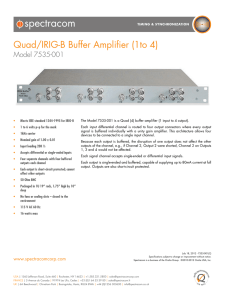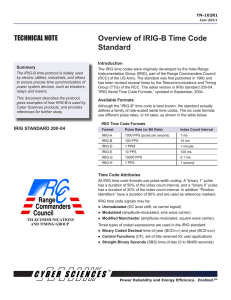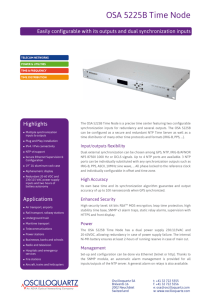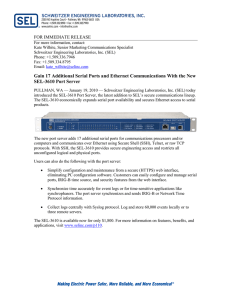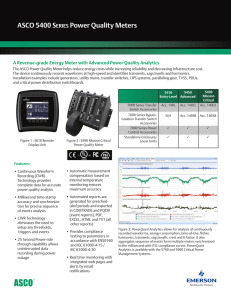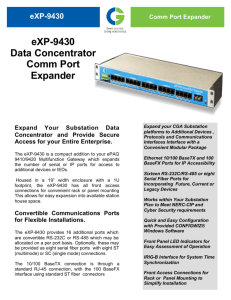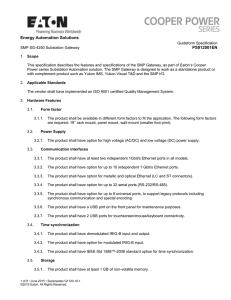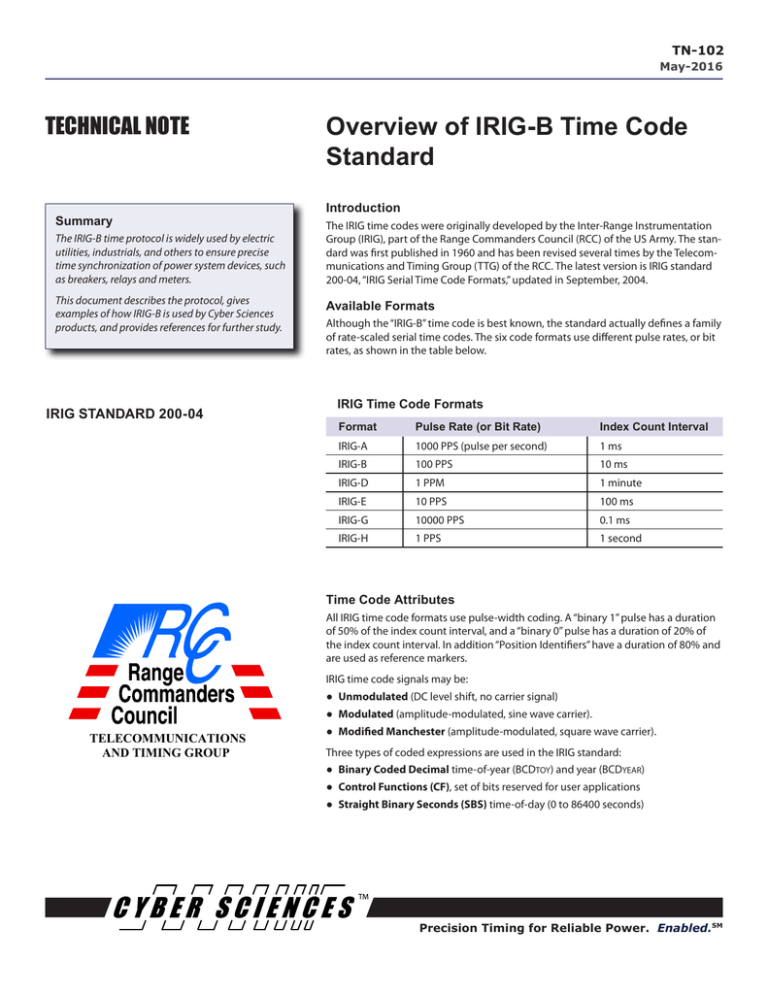
TN-102
May-2016
TECHNICAL NOTE
Overview of IRIG-B Time Code
Standard
Introduction
Summary
The IRIG-B time protocol is widely used by electric
utilities, industrials, and others to ensure precise
time synchronization of power system devices, such
as breakers, relays and meters.
This document describes the protocol, gives
examples of how IRIG-B is used by Cyber Sciences
products, and provides references for further study.
The IRIG time codes were originally developed by the Inter-Range Instrumentation
Group (IRIG), part of the Range Commanders Council (RCC) of the US Army. The standard was first published in 1960 and has been revised several times by the Telecommunications and Timing Group (TTG) of the RCC. The latest version is IRIG standard
200-04, “IRIG Serial Time Code Formats,” updated in September, 2004.
Available Formats
Although the “IRIG-B” time code is best known, the standard actually defines a family
of rate-scaled serial time codes. The six code formats use different pulse rates, or bit
rates, as shown in the table below.
IRIG Time Code Formats
IRIG STANDARD 200-04
Format
Pulse Rate (or Bit Rate)
Index Count Interval
IRIG-A
1000 PPS (pulse per second)
1 ms
IRIG-B
100 PPS
10 ms
IRIG-D
1 PPM
1 minute
IRIG-E
10 PPS
100 ms
IRIG-G
10000 PPS
0.1 ms
IRIG-H
1 PPS
1 second
Time Code Attributes
All IRIG time code formats use pulse-width coding. A “binary 1” pulse has a duration
of 50% of the index count interval, and a “binary 0” pulse has a duration of 20% of
the index count interval. In addition “Position Identifiers” have a duration of 80% and
are used as reference markers.
IRIG time code signals may be:
IRIG STANDARD 200-04
●● Unmodulated (DC level shift, no carrier signal)
●● Modulated (amplitude-modulated, sine wave carrier).
TELECOMMUNICATIONS
AND TIMING GROUP
●● Modified Manchester (amplitude-modulated, square wave carrier).
Three types of coded expressions are used in the IRIG standard:
●● Binary Coded Decimal time-of-year (BCDTOY) and year (BCDYEAR)
●● Control Functions (CF), set of bits reserved for user applications
IRIG SERIAL TIME
CODE
FORMATS
●● Straight
Binary Seconds
(SBS) time-of-day (0 to 86400 seconds)
WHITE SANDS MISSILE RANGE
REAGAN TEST SITE
YUMA PROVING GROUND
DUGWAY PROVING GROUND
Precision Timing for Reliable Power.
ABERDEEN TEST CENTER
NATIONAL TRAINING CENTER
ELECTRONIC PROVING GROUND
Enabled.SM
TN-102 | May-2016
IRIG STANDARD 200-04 (Continued)
TECH NOTE—Overview of IRIG-B Time Code Standard
IRIG Time Code Designations
In addition to the letter used to designate one of the six IRIG code formats, signal
identification numbers are used to further describe specific characteristics. Thus, the
complete IRIG time code designation consists of a letter and three digits, as shown
below.
Unmodulated or Demodulated?
Format (A, B, D, E, G or H)
An IRIG-B time signal can be modulated (over a
carrier signal) or unmodulated (no carrier signal),
called DC Level Shift (DCLS) in the IRIG Standard.
Modulation
Carrier Frequency / Resolution
In some manufacturers’ literature, the term
“demodulated” is used to describe an IRIG-B DC
Level Shift (no carrier signal). In most cases, it may
be assumed that this term is synonymous with
unmodulated (DCLS).
Coded Expressions
B006
IRIG time codes – naming convention
IRIG Signal Identification Numbers (3 Digits)
2
www.cyber-sciences.com
1st Digit
Modulation
0
Unmodulated, DC Level Shift (DCLS), pulse-width coded
1
Amplitude modulated, sine wave carrier
2
Manchester modulated
2nd Digit
Carrier Frequency / Resolution
0
No carrier (DCLS)
1
100 Hz / 10 ms resolution
2
1 kHz / 1 ms resolution
3
10 kHz / 100 microsecond resolution
4
100 kHz / 10 microsecond resolution
3rd Digit
Coded Expressions
0
BCDTOY, CF, SBS
1
BCDTOY, CF
2
BCDTOY
3
BCDTOY, SBS
4
BCDTOY, BCDYEAR, CF, SBS
5
BCDTOY, BCDYEAR, CF
6
BCDTOY, BCDYEAR
7
BCDTOY, BCDYEAR, SBS
© 2011-2016 Cyber Sciences, Inc. All rights reserved.
TECH NOTE—Overview of IRIG-B Time Code Standard
IRIG-B PROTOCOL DESCRIPTION
TN-102 | May-2016
IRIG-B Overview
IRIG time code B (IRIG-B) is widely used in the electrical power industry. IRIG-B has
a pulse rate of 100 pulses-per-second with an index count of 10 milliseconds over
its one-second time frame. It contains time-of-year and year information in a BCD
format, and (optionally) seconds-of-day in SBS.
IRIG-B Signals
IRIG-B is typically distributed as a DC level shift (DCLS), pulse-width coded signal
(“unmodulated IRIG-B”) or as an amplitude-modulated signal based on a sine wave
carrier with a frequency of 1kHz (“modulated IRIG-B”). Modified Manchester modulation is also specified in the standard but is less common. A comparison of IRIG-B
coding methods is shown in the figure below.
Figure 4-2.
(source: IRIG Standard 200-04)
IRIG B coding comparisons: level shift, 1kHz am, and Modified Manchester.
IRIG-B coding comparisons: DC level shift (unmodulated), 1kHz amplitude-modulated, and Modified Manchester
IRIG-B Reference Markers
IRIG-B uses reference markers called “Position Identifiers.” The presence of two
consecutive reference markers signifies the start of the time frame. The first reference marker alerts that the next rising edge will be the PPS marker. (“On-Time 1 PPS”
shown above.)
Figure 4-3.
Modified Manchester coding.
© 2011-2016 Cyber Sciences, Inc. All rights reserved.
www.cyber-sciences.com
3
TN-102 | May-2016
TECH NOTE—Overview of IRIG-B Time Code Standard
IRIG-B PROTOCOL DESCRIPTION
(Cont.)
IRIG-B Encoding
IRIG-B consists of 100 bits produced every second, 74 bits of which contain various
time, date, time changes and time quality information of the time signal. Consisting of logic ones, zeros and position identifier bits, the time code provides a reliable
method of transmitting time to synchronize power equipment devices. There are
three functional groups of bits in the IRIG-B time code: Binary Coded Decimal (BCD),
Control Functions (CF) and Straight Binary Seconds (SBS).
The BCD group contains time information including seconds, minutes, hours and
days, recycling yearly. The BCD time-of-year code (BCDTOY) reads zero (0) hours, minutes, seconds, and fraction of seconds at 2400 each day and reads day 001 at 2400
of day 365, or day 366 in a leap year. The BCD year code (BCDYEAR) counts year and
cycles to the next year on January 1st of each year and will count to year 2099.
The (optional) SBS time-of-day code consists of the total elapsed seconds, recycling
daily. SBS reads zero (0) seconds at 2400 each day excluding leap second days when
a second may be added or subtracted.
The CF group contains year, time quality, leap year, pending leap seconds and parity.
Other CF bits are reserved for user-defined purposes, depending on application.
Lastly, position identifiers separate the various components of the IRIG-B time code.
IEEE-1344 Extensions
Note: IEEE standard 1344 was updated and replaced
by IEEE C37.118-2005. Nonetheless, the term “IEEE1344 Extensions” is still used.
Year information was not specified in the IRIG standard prior to its 2004 revision. Before 2004, the IEEE adopted a standard (IEEE-1344) which included year data as part
of the IRIG-B signal. This variation came to be known as “IEEE-1344 extensions.”
IEEE-1344 extensions use extra bits of the Control Functions (CF) portion of the IRIGB time code. Within this portion of the time code, bits are designated for additional
features, including:
●● Calendar Year (now called BCDYEAR)
●● Leap seconds, and leap seconds pending
●● Daylight Saving Time (DST), and DST pending
●● Local time offset
●● Time quality
●● Parity
●● Position identifiers
IRIG-B Type with IEEE 1344 Extensions
IRIG-B TYPE
4
IEEE 1344
OFF
ON
Unmodulated, B00x
B002
B006
Modulated, B12x
B122
B126
www.cyber-sciences.com
To be able to use these extra bits of information, power system devices and other
equipment receiving the time code must be able to decode them. Refer to individual
product manuals to determine whether IEEE-1344 extensions are supported.
Since year information is now considered part of BCD (denoted as BCDYEAR), what
was formerly considered B002 and B122 (with IEEE Extensions ON) would now be
denoted as B006 and B126.
© 2011-2016 Cyber Sciences, Inc. All rights reserved.
TECH NOTE—Overview of IRIG-B Time Code Standard
TN-102 | May-2016
(source: IRIG Standard 200-04)
IRIG-B BCD time-of-year (in days, hours, minutes, seconds) and year and straight binary seconds-of-day and control bits
WIRING
IRIG-B Implementation
The IRIG 200-04 standard does not define specific signal levels for IRIG-B.
Typical techniques for transmission of unmodulated IRIG-B (DCLS) include:
●● 5V signal over coaxial cable or shielded twisted-pair cable
●● Multi-point distribution using 24 Vdc for signal and control power
●● RS-485 differential signal over shielded twisted-pair cable
●● RS-232 signal over shielded cable (short distances only)
●● Optical fiber
Typical techniques for transmission of modulated IRIG-B include:
●● Coaxial cable, terminated in 50 ohms or higher, point-to-point
●● Shielded twisted-pair cable
© 2011-2016 Cyber Sciences, Inc. All rights reserved.
www.cyber-sciences.com
5
TN-102 | May-2016
APPLICATION OF IRIG-B IN CSI
PRODUCTS
STR-100
Satellite Time Reference
If Modulated IRIG-B input is used, the STR-100 must
be configured with the current year during initial
setup. The full date/time (including the year) is
transmitted via its DCF77 outputs.
TECH NOTE—Overview of IRIG-B Time Code Standard
STR-100
The Cyber Sciences STR-100 Satellite Time Reference accepts a GPS smart antenna
input or a modulated IRIG-B signal to provide a precision time reference. The IRIG-B
input supports type B122 (1kHz modulated signal with time of year).
Acutime GG
GPS Antenna Input
OR
CH 2
DCF77 Output
(or 1per10)
STR-100
Satellite Time Reference
DCF77 Output
}
(optional)
24V levels
STR-100/IRIG-B
Like the base model, the STR-100/IRIG-B accepts a GPS smart antenna input, but its
output is an unmodulated IRIG-B signal, type B006 (unmodulated signal, DC level
shift, BCDTOY and BCDYEAR) at 5V (side BNC) or 24V (front terminals).
Acutime GG
GPS Antenna Input
The STR-100/IRIG-B outputs an IRIG-B time code
with full date/time, including the year. This is
sometimes called IEEE-1344 extensions enabled.
The latest IRIG standard incorporates these “extensions” (type B006).
(optional)
BNC-to-screwterminal adapter
24 Vdc
control power
Unmodulated
IRIG-B Output
(5V levels)
STR-100/IRIG-B
Satellite Time Reference
STR-IDM
IRIG-B Distribution Module
BNC-to-screwterminal adapter
24 Vdc
control power
CH 1
STR-100/IRIG-B
Satellite Time Reference
Modulated
IRIG-B Input
IRIG-B @ 24V levels, plus
24 Vdc control power
(to STR-IDM)
STR-IDM
The STR-IDM IRIG-B Distribution Module enables the distribution of an unmodulated
IRIG-B signal over long distances and to multiple devices. The IRIG-B signal levels between the STR-100/IRIG-B and the IDM (as well as to other IDMs) are 24 Vdc nominal,
along with 24 Vdc control power. Each STR-IDM provides 8 additional IRIG-B outputs,
type B006 (unmodulated signal, 5V DC level shift, BCDTOY and BCDYEAR)
24V IRIG-B plus 24 Vdc power
(from PLX-24V or
STR-100/IRIG-B
24V IRIG-B plus 24 Vdc power
(to next STR-IDM)
STR-IDM
IRIG-B Distribution Module
Unmodulated IRIG-B
Outputs (x8)
(5V levels)
6
www.cyber-sciences.com
© 2011-2016 Cyber Sciences, Inc. All rights reserved.
TN-102 | May-2016
TECH NOTE—Overview of IRIG-B Time Code Standard
SER-3200 / SER-2408
Sequence of Events Recorder
SER-3200/2408
The CyTimeTM Sequence of Events Recorders, SER-3200 and SER-2408, accept an
unmodulated IRIG-B signal as precision time reference, and support IEEE-1344 extensions, type B006 (unmodulated signal, DC level shift pulse, BCDTOY and BCDYEAR).
These devices also accept other time-sourceoptions, including PTP (IEEE 1588),
DCF77, SER Inter-device (RS-485), NTP and Modbus TCP.
When the time source is PTP, the CyTime SER can also output IRIG-B via a PTP Legacy
Interface, PLX-5V or PLX-24V. The PLX-5V is used to output the conventional IRIG-B
signal, type B006 (unmodulated, 5V DC level shift pulse, with BCDTOY and BCDYEAR).
Alternatively, the PLX-24V outputs a 24V IRIG-B signal for use with the STR-IDM.
EZC-DCF77 or
EZC-IRIG-B
PLX-5V or
PLX-24V
Unmodulated IRIG-B
or DCF77 Input
PTP, NTP or Modbus TCP
Time Source
(over Ethernet)
(optional)
(optional)
OR
IRIG-B,
DCF77
or 1per10
OUT
24 Vdc
control power
CyTimeTM SER-3200 (or SER-2408)
Sequence of Events Recorder
REFERENCES
For More Information
Tech Note: Hi-res Time Sync using PTP/1588 (TN-100)
Tech Note: SER System Architectures (TN-101)
Tech Note: DCF77 Time Protocol (TN-103)
Tech Note: 1per10 Time Protocol (TN-104)
CyTime SER User’s Guide (IB-SER-01)
CyTime SER Reference Guide (IB-SER-02)
ASCII / RS-485 OUT
(or Inter-SER IN/OUT)
References
IRIG Standard 200-04: “IRIG Serial Time Code Formats.” September, 2004. Range Commanders Council, U.S. Army White Sands Missile Range, New Mexico 88002-5110
IEEE C37.118-2005 (replaced IEEE Standard 1344). IEEE Standard for Synchrophasors
for Power Systems. Institute of Electrical and Electronics Engineers (IEEE). January 1,
2006.
Dickerson, Bill, P.Eng., Arbiter Systems, Inc. “Time in the Power Industry: How and
Why We Use It.”
Dickerson, Bill, P.Eng., Arbiter Systems, Inc. “IRIG-B Time Code Accuracy and Connection Requirements with comments on IED and system design considerations.”
Publication PD0037300.
EZC Instruction Bulletin (IB-EZC-01)
PLX Instruction Bulletin (IB-PLX-01)
STR-100 Instruction Bulletin (IB-STR-01)
STR-100/IRIG-B Addendum (IB-STR-02)
STR-IDM Instruction Bulletin (IB-IDM-01)
© 2011-2016 Cyber Sciences, Inc. All rights reserved.
www.cyber-sciences.com
7
TN-102 | May-2016
TECH NOTE—Overview of IRIG-B Time Code Standard
The service marks, “Precision Timing for Reliable Power. Enabled.” and “I-Heart-1588”,
CyTime, and the Cyber Sciences stylized logo are trademarks of Cyber Sciences.
All other trademarks are the property of their respective owners.
MADE IN USA
Cyber Sciences, Inc. (CSI)
229 Castlewood Drive, Suite E
Murfreesboro, TN 37129 USA
Tel: +1 615-890-6709
Fax: +1 615-439-1651
8
www.cyber-sciences.com
RoHS
Pb
Lead-Free
I
1588
SM
Doc. no: TN-102 May-2016
(supersedes doc. dated Jan-2014)
© 2011-2016 Cyber Sciences, Inc. All rights reserved.

